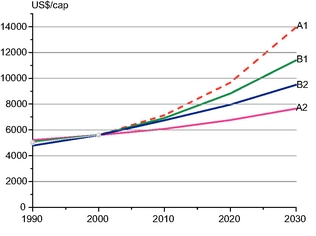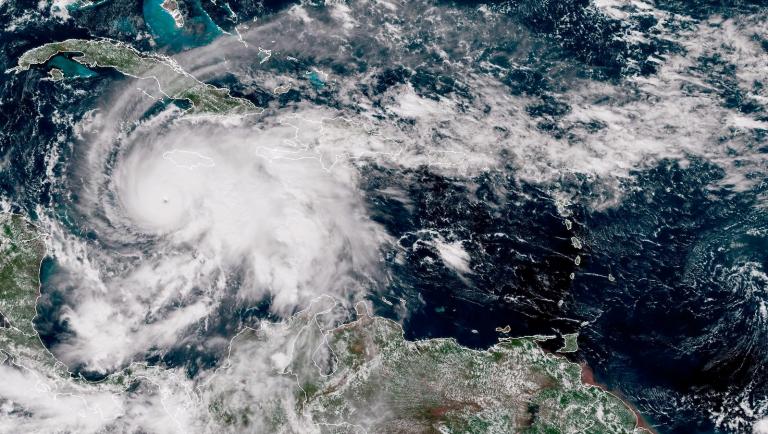As I see it, there are two incommensurate stories being told about climate change. I’m not talking about the largely fake debate between those who say climate change is happening and human-driven (scientists) and those who say it isn’t (the GOP). I’m talking about two different ways of envisioning what we can expect in a climate-changed future, both of which exist among people who take climate change seriously. Sometimes they take up residence in the same head! Like, er, mine. But they don’t fit together very well. One comes to us from science, the other from economics.
Eban Goodstein wrote a post on Grist about this last week. It was a bit wonky so it may have slipped through the cracks, but it’s important, so I’m going to resurface and sensationalize it! (Just one of the services we provide here at Grist.)
In this corner: science
 “Permafrost what?”Climate scientists are becoming increasingly panicked as new evidence rolls in and just about every bit is worse than the last. The impacts of climate change are coming faster and harder than most models predicted, and there’s a real — if maddeningly difficult to quantify — risk of civilization-threatening scenarios that sound like bad sci-fi movies.
“Permafrost what?”Climate scientists are becoming increasingly panicked as new evidence rolls in and just about every bit is worse than the last. The impacts of climate change are coming faster and harder than most models predicted, and there’s a real — if maddeningly difficult to quantify — risk of civilization-threatening scenarios that sound like bad sci-fi movies.
The standard line among climate hawks is that science recommends “80 percent reduction of greenhouse gas emissions by 2050.” (That’s for developed world countries; globally, the target is 50 percent by 2050.) But that recommendation is based on the last IPCC report, which is by all accounts woefully conservative, especially given that the science since then has been uniformly grim. There’s good reason to think these official consensus forums underestimate the severity of the problem.
To get back below the more ambitious target of 350 ppm of CO2 in the atmosphere (which we’re already well above), the U.S. and other rich countries will probably have to get close to zero carbon by 2050, with the developing world not far behind.
Few people understand how brain-explodingly ambitious that is. Certainly no one in the U.S. political establishment. Whether you think it’s necessary and affordable in the grand scheme of things (I do), there’s no denying it’s a huge honking lift. Watch the video of super-nerd Saul Griffith below for a taste. It will change your life.
[vodpod id=ExternalVideo.1011866&w=425&h=350&fv=webhost%3Dfora.tv%26clipid%3D8907%26cliptype%3Dclip]
Or contemplate this: To reach even the more modest target of 450ppm, reports David Biello, the IEA says humanity would have to build the following every year between now and 2050:
… 35 coal-fired and 20 gas-fired power plants with carbon capture and storage; 30 nuclear power plants; 12,000 onshore wind turbines paired with 3,600 offshore ones; 45 geothermal power plants; 325 million square meters-worth of photovoltaics; and 55 solar-thermal power plants. That doesn’t even include the need to build electric cars and hydrogen fuel cell vehicles in order to shift transportation away from burning gasoline.
That represents a level of sustained economic, social, and technological transformation that is difficult to fathom. It’s the equivalent of America’s massive industrial build-up for WWII, only across the entire globe, for 40 years straight (at least), against a faceless enemy.
The mind boggles at the scale of what scientists are urging us to do. So … should we do it? Is such a massive shift “worth it”? Funny you should ask.
In this corner: economics
Economists are the arbiters of “worth it” these days, so how do they figure it out?
In short, they build models (like this one). Informing those models are various assumptions about the range of damages expected from climate change, the range of costs expected from avoiding climate change, and the rate of economic growth. The general idea is to find the right balance between spending on mitigation/adaptation and the cost of potential damages, so that we don’t overpay or underpay. Rather, like Goldilocks, economists seek a course of action that’s just right: the most economically efficient course.
 “I see rich people.”IPCC Fourth Assessment ReportFor the present discussion, the salient fact is that virtually all the economic models used for this purpose share something in common: they show human beings getting richer over the next century, regardless of what the climate does. Depending on which numbers and assumptions are plugged in, they output a range of scenarios from much-richer-very-quickly to … somewhat-less-richer-more-slowly. But none of them show human progress hitting any kind of plateau, much less falling off a cliff. Goodstein:
“I see rich people.”IPCC Fourth Assessment ReportFor the present discussion, the salient fact is that virtually all the economic models used for this purpose share something in common: they show human beings getting richer over the next century, regardless of what the climate does. Depending on which numbers and assumptions are plugged in, they output a range of scenarios from much-richer-very-quickly to … somewhat-less-richer-more-slowly. But none of them show human progress hitting any kind of plateau, much less falling off a cliff. Goodstein:
My E3 colleague Frank Ackerman has noted that even assuming what [British economist Nicholas] Stern characterizes as an extreme worst case scenario — a 35 percent reduction in income below baseline — then the world would “only” be eight times richer in 2200. Similarly, the IPCC’s four “marker scenarios” all forecast developing country per capita GDP to equal that of industrial countries in 1990, beginning in 2050 (scenario A1B), to out beyond 2100 (scenario A2).
From what economists tell us, it looks like the worst thing policymakers risk on climate change is somewhat slower economic growth. One way or another, we’re getting wealthier.
This represents what is perhaps the foundational faith of modern economics: a faith in human adaptability and ingenuity. Especially via the distributed decisionmaking represented by open markets, humans can master almost any circumstances given time. (For a recent example of this optimism on Grist, see economist Matthew Kahn.)
Nowhere in these models will you find any hint of Diamond– or Lovelock-style apocalypse. Instead, future people will be much wealthier and, because of that, better able to cope with the problem.
How do we reconcile these two stories? Is climate change truly an existential threat — an immediate danger and a small but growing risk of substantial societal collapse? Or is it a creeping change to which humanity needs to make a carefully calibrated, economically optimized response as it continues to flourish? How do we fit these two visions in our heads? And more importantly, what, given these different visions, should we do?
And the winner is …
Of course, economists would tell you that they have reconciled those stories — that’s what the models do. The damages of climate change are built right in. The results don’t look like catastrophe because, dammit, Man Will Overcome.
 Anyway, that’s what the models will tell you. But if you talk to the economists themselves, they’re not quite as gung ho. For one thing, they will admit that their models aren’t very good at incorporating large short-term shocks. The “long tail” possibilities in climate science — the low-probability, high-impact stuff like ice shelves collapsing or thermohaline circulation shutting down — completely borks the models. You start seeing wild, arbitrary swings in model projections based on small adjustments in input assumptions. The models start saying, in essence, “hell if I know!” (Economist Martin Weitzman has done good work on this; Romm has a digestible summary.)
Anyway, that’s what the models will tell you. But if you talk to the economists themselves, they’re not quite as gung ho. For one thing, they will admit that their models aren’t very good at incorporating large short-term shocks. The “long tail” possibilities in climate science — the low-probability, high-impact stuff like ice shelves collapsing or thermohaline circulation shutting down — completely borks the models. You start seeing wild, arbitrary swings in model projections based on small adjustments in input assumptions. The models start saying, in essence, “hell if I know!” (Economist Martin Weitzman has done good work on this; Romm has a digestible summary.)
When economists run into the limitations of their models, they tend to heed the Wittgensteinian injunction: Whereof one cannot speak, thereof one must be silent. They don’t feel comfortable making policy recommendations without solid modeling to back it up. Giving counsel in the face gigantic, unquantifiable risks starts to feel less like science and more like an exercise in politics or ethics. Heaven forbid.
Unfortunately, that leaves the field to economists like William Nordhaus, whose model tells a soothing story of slowly rising costs, smoothly offset by a slowly rising carbon tax. The message: don’t panic. That message is all too welcome in the halls of power.
Getting clear on this is ultimately going to require a lot of progress in both science and economics. But for my part, when I see scientists panicking and economists telling me not to panic … my palms start sweating.
Humanity has never had to grapple with a problem that measures itself in centuries, threatens our very existence, and requires global cooperation to overcome. We are fairly beset by gaping uncertainties. We know it could get really bad, but we don’t know exactly how bad it will get, or how fast, or where. We don’t know how much it will cost to re-engineer the world along sustainable lines, or how quickly we can do it, or even whether we can do it at all.
We are stumbling around in the dark, in an area where scientists tell us some very, very nasty beasties dwell. In that situation, it seems to me the overwhelming bias should be toward action — getting lean, mean, and nimble enough to handle ourselves no matter what slouches our way.



